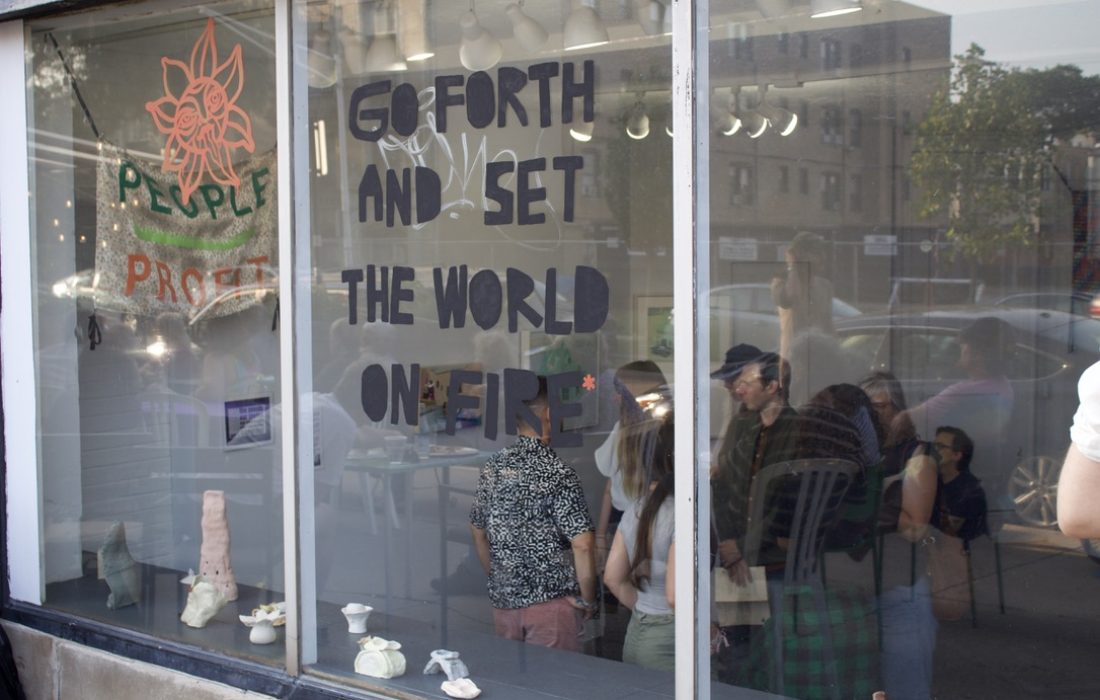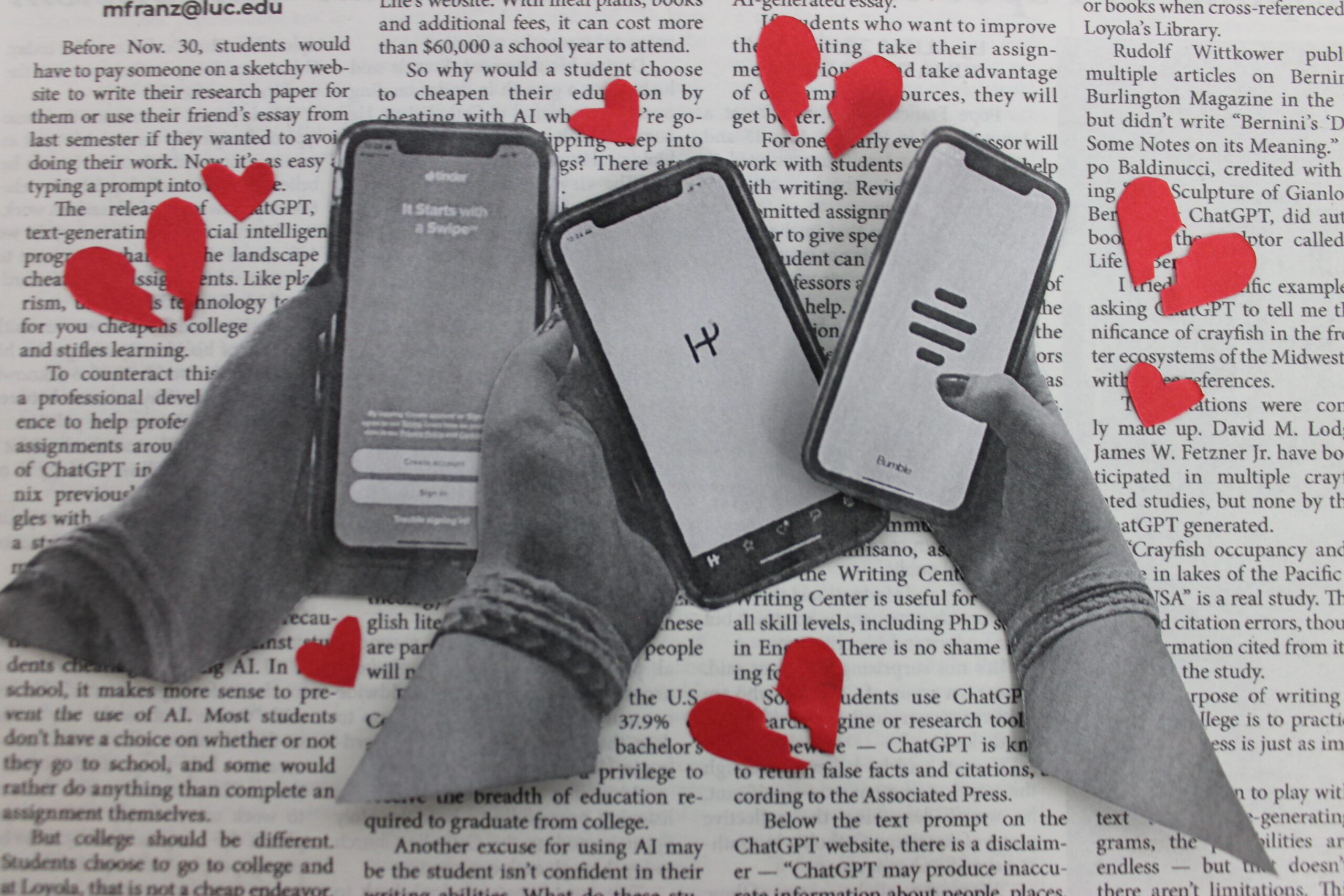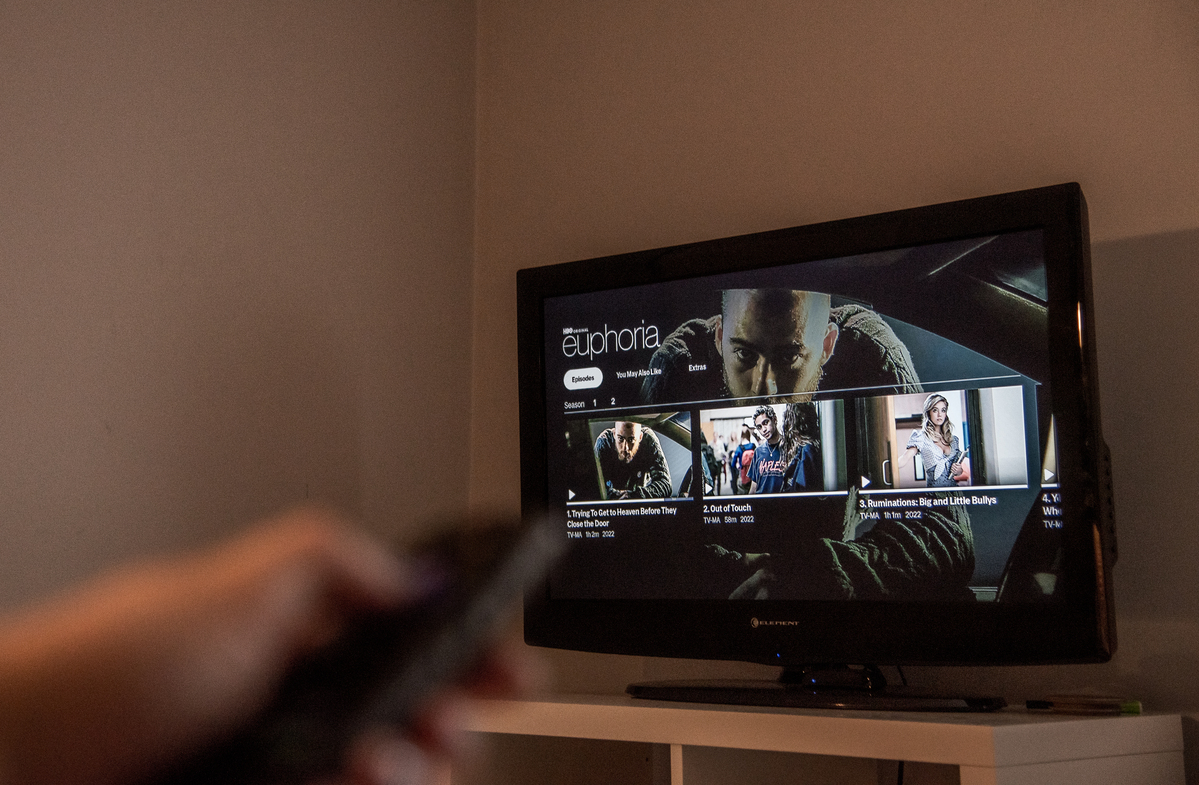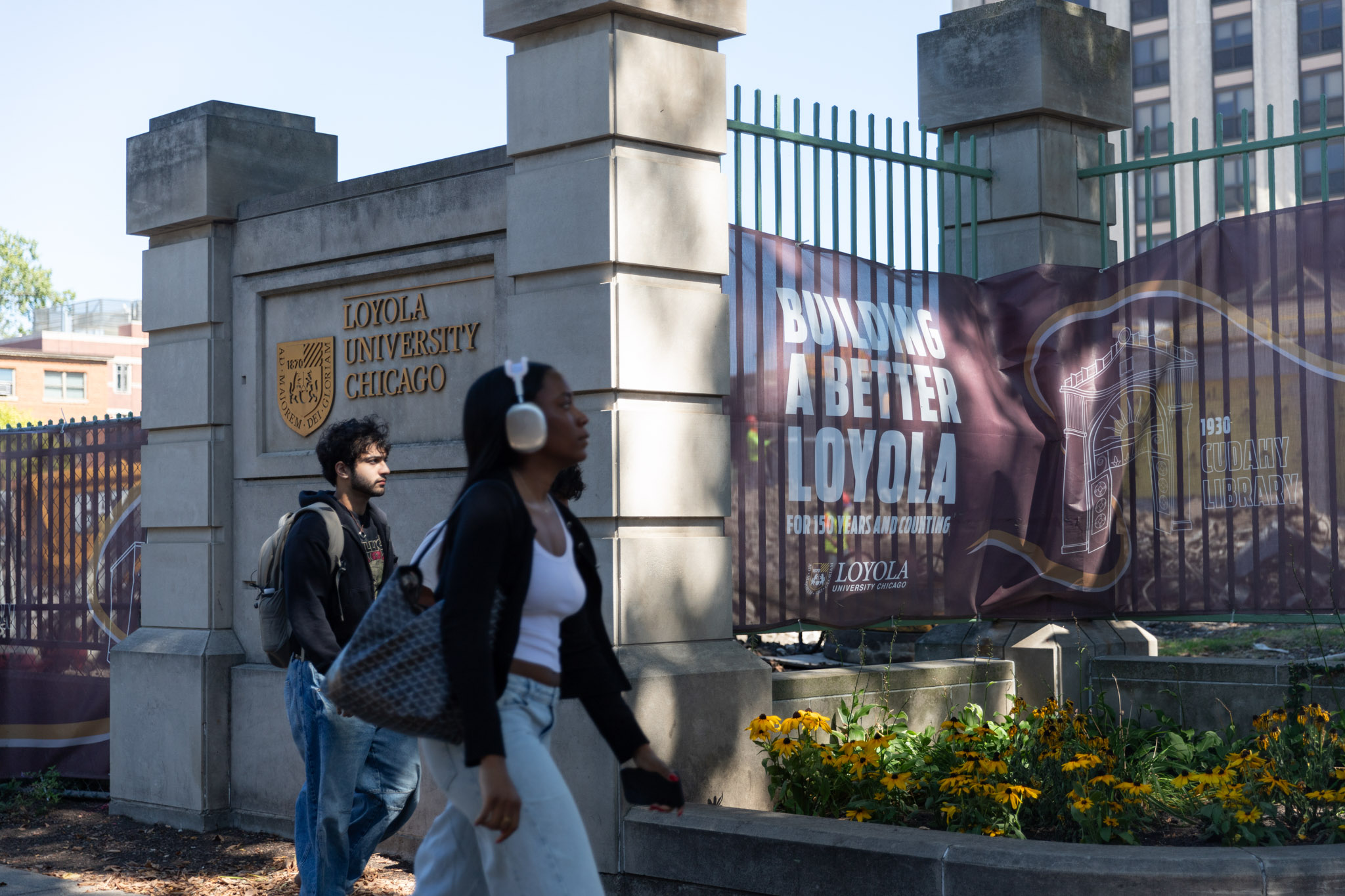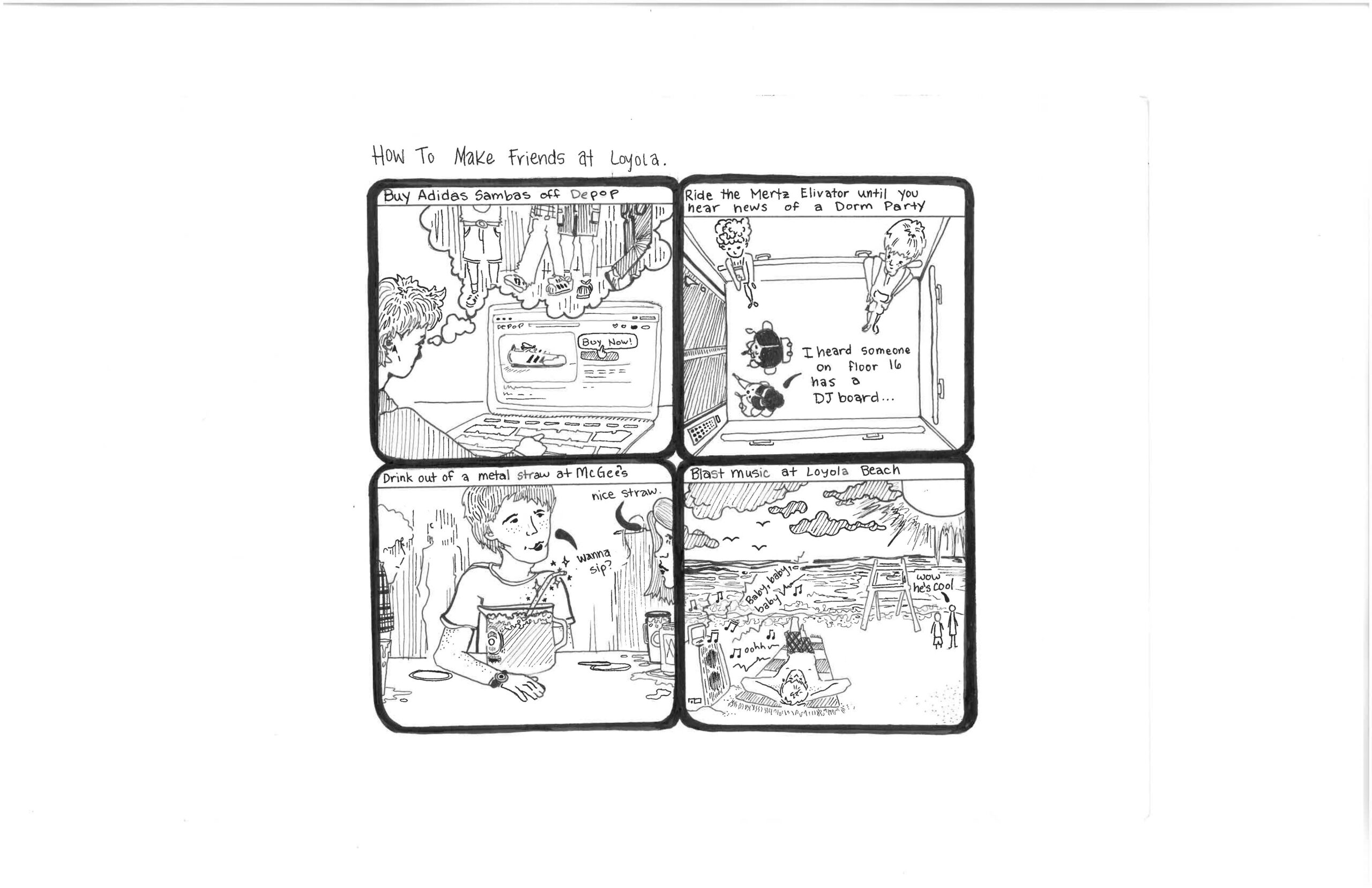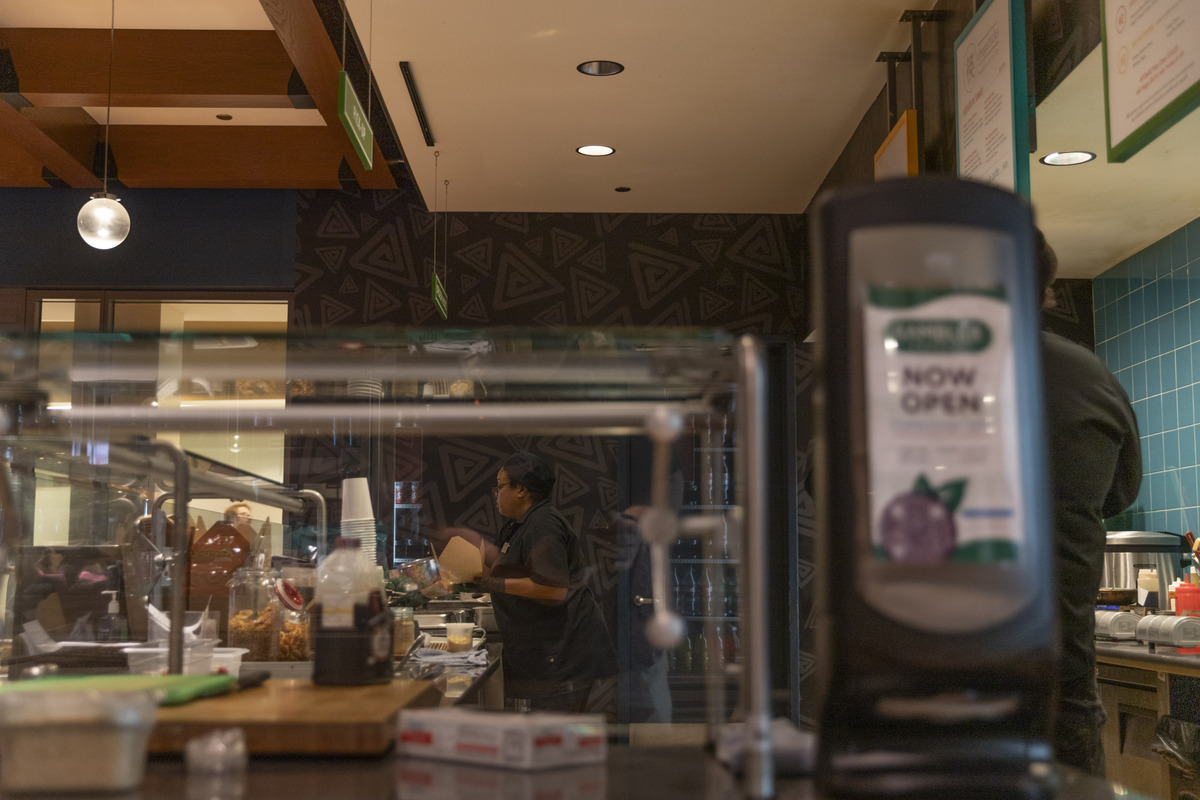The exhibit — on display through Aug. 18 — includes works created by the building’s tenants, community members and Loyola professors.
Art Show Honoring Soon To Be Demolished 1224 W. Loyola Ave. Ignites Community
In a wide-windowed gallery space, under the cover of murmured mingling and live music, an artist stands in the building at 1224 W. Loyola Ave. he calls home.
As groups of people buzz around the building, the artist — who goes by AJ — perches proudly by his collection of colorful photos pinned on a wall perpendicular to the gallery’s front door. He animatedly talks to anyone who meanders by, describing the nuances of particular shots and the joy he feels when capturing emotional moments.
The photos are part of the show “Go forth and set the world on fire,” an exhibit organized by art non-profit Roman Susan, which opened July 19. The exhibit — on display through Aug. 18 — includes works created by the building’s tenants, community members and individuals associated with Loyola, including six current and four former university faculty members.
For AJ, sharing his artwork with the community is a highlight in what he called a “traumatic” last six months. As a residential tenant of 1234 W. Loyola Ave., which was purchased by Loyola in December, AJ will be forced to move out at the end of his lease.
“I can’t sugarcoat it, it’s a really traumatic experience,” AJ said. “It’s disruption, it’s upheaval, it’s displacement and it’s a recurrent history of that.”
Despite this adversity, AJ said the support from Roman Susan and others in the neighborhood have made him see Rogers Park in a new, community-oriented light — a side of the neighborhood he hadn’t seen in his six years of residency.

(Marky Salvati | The Phoenix)
“Through this upheaval and tremendous community outpouring of support and the neighborhood rallying against what Loyola is doing, I’ve become more connected to Rogers Park,” AJ said.
Partners and Roman Susan founders Nathan and Kristin Abhalter-Smith said supporting tenants was their primary goal when planning the show. They said upon learning the building was going to be sold, they budgeted $7,000 at the beginning of the year for an art show that could include tenants and celebrate the building.
The show features works from 19 individuals and organizations, ranging from paintings, protest banners, historical documents and performance poetry. The Abhalter-Smiths said for this show they wanted to focus on collaboration between Loyola and the community.
The Abhalter-Smiths have been outspoken about the cultural and communal significance of the building since the purchase. They wrote a statement to Loyola in January imploring the university to consider the building’s tenants and local businesses.
As the situation developed and Loyola announced plans for demolition, the Abhalter-Smiths felt compelled to aid the displaced tenants. In addition to writing an addendum to their original statement, they’ve also been liaisons between residents and Loyola’s Office of Neighborhood Initiatives.
Jennifer Clark, the director of Loyola’s Office of Neighborhood Initiatives, wrote in an email to The Phoenix the Abhalter-Smiths have helped the university ensure every tenant could be contacted.
“Loyola has had productive and open dialogue with all 23 tenants in the building,” Clark wrote. “The owners of Roman Susan, Nathan and Kristen, have been valuable partners in helping us to connect with hard-to-reach residents. As stated in the addendum, all tenants were able to stay to the end of their lease agreements and some tenants had their leases extended.”
While helping tenants contact Loyola, the Abhalter-Smiths received a $7,000 grant from the Crossroads Fund’s Critical Response Fund. The grant — in addition to some of their own funds — has allowed them to pay both artists involved in “Go forth and set the world on fire” and set aside $500 stipends for every household in the building.
So far 13 of 23 applicable households have accepted the stipend, according to the Abhalter-Smiths. Nathan Abhalter-Smith said they are still working on contacting tenants who haven’t responded to their offer.
“The version 1.0 was we were going to ask a bunch of artists to volunteer to be in the show and we were going to donate their stipends to the people in the building,” Nathan Abhalter-Smith said. “And so the additional funding let us stick with our sort of bedrock everyone-gets-paid.”
One year from now, “Go forth and set the world on fire” will return, this time with an emphasis on celebrating a community united. The Abhalter-Smiths said the show’s name — a reference to St. Ignatius of Loyola, founder of the Jesuits and the university’s namesake — comments on sustainability and the waste of tearing down buildings as well as being a call to action to foster change.
“I feel like it’s provocative in terms of everything that’s going on in the world right now, and I think that it’s poetic and kind of incendiary,” Kristin Abhalter-Smith said.
The Abhalter-Smiths said they were partially inspired to help tenants by Sonya Bogdanova, a ceramics professor at the School of the Art Institute Chicago. Bogdanova, who spent much of her childhood in West Rogers Park, hosted a free ceramics class for community members as part of “Go forth and set the world on fire.”

“I felt selfish making my own stuff,” Bogdanova said. “This was a way of, at the very least, joining the right side of history.”
Bogdanova said she approached the workshop with a free-form mindset, as she simply explained the essential tenets of claywork and allowed participants to craft whatever they wanted. She described the experience as almost democratic, recollecting the creative atmosphere adorned by the jazz band playing next door at Archie’s cafe.
“It was like,‘This is how we should be living,’” Bogdanova said.
Another contributor touched by the show’s collaborative thesis was artist and Drawing and Painting professor Gina Hunt. As a lecturer of Fine Arts at Loyola, Hunt said she was moved by the Abhalter-Smiths’ synergistic perspective despite the situation’s complexity.
“Nathan and Kristin reached out to me as someone who is affiliated with this university in a way that wasn’t bringing any sort of contention or conflict to this dialogue,” Hunt said. “It was like, ‘Let’s work together to do this presentation of this project in support of the people that are important to the space and this building.’”
asd
Although the show emphasizes collaboration with the university, it still contains an element of protest. Inside the gallery space, banners sporting aphorisms like “stop repeating history” were interwoven between the artworks.
The show also refers to past protests, including documents from the Edgewater Environmental Coalition protesting Loyola’s demolition of two buildings on Kenmore Ave. in 2018.
Rafael Vera, a contributing artist and senior lecturer of fine arts at Loyola, underscored these elements of protest. Vera said his submission explores his personal feelings of nostalgia and displacement as a Venezuelan immigrant, yet he felt the themes were applicable to the tenants’ situations.
“I feel a sense of protest,” Vera said. “I am 100% in support of the people who live in the building and very much Roman Susan, who have done an incredible job and who have been a very important part of our community at Loyola and at Rogers Park and in Chicago.”
For some contributors, however, this sense of protest was more subtextual. Laura Goldstein, a senior lecturer in core Literature and Writing, prepared a spoken-word performance called “The Tower,” which will be performed Aug. 1 with former Loyola student Cean Gamalinda.
Goldstein said they took inspiration from the Torah’s “Tower of Babel” story to explore themes of communication and analyze the language of the community versus the language of “the institution.” Goldstein hopes their work prompts listeners to think deeply about the situation and inspire change.
“Whatever is created can be destroyed at any moment at the whims of power,” Goldstein said. “That’s what I really wanted to look at.”

This dialogue is what the Abhalter-Smiths said they want to facilitate with the show. Although they said they know change is inevitable, they hope it can come about in a collaborative and creative way.
“There are more possibilities than the thought of tearing this building down,” Kristin Abhalter-Smith said. “They have a lot of reasons why they would justify taking the building away, but why not have a more creative solution?”
For AJ, creativity is an overt and pointed form of rebellion and self-love. He said despite looming uncertainty over his future, his art serves as a constant reminder of his resilience.
“This is me, this is my life, these are my experiences, these are things that are important to me,” AJ said, looking fondly at his photos on the wall of 1224 W. Loyola Ave. “And I’m not going to let Loyola extinguish that flame.”
“Go forth and set the world on fire” is on display at Roman Susan until Aug. 18. The Gallery is free and open for visitors Wednesdays and Thursdays 4 p.m. to 7 p.m.

